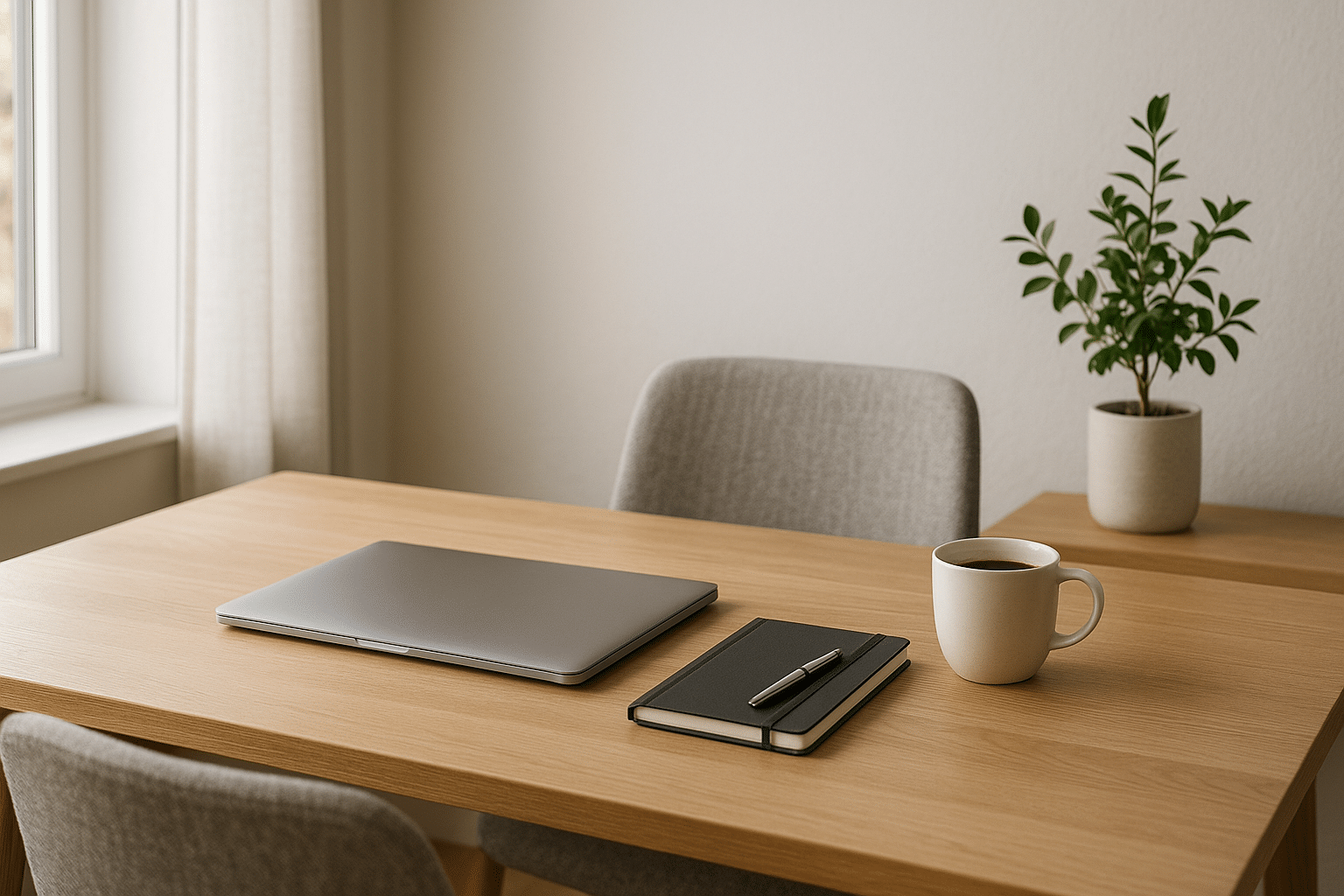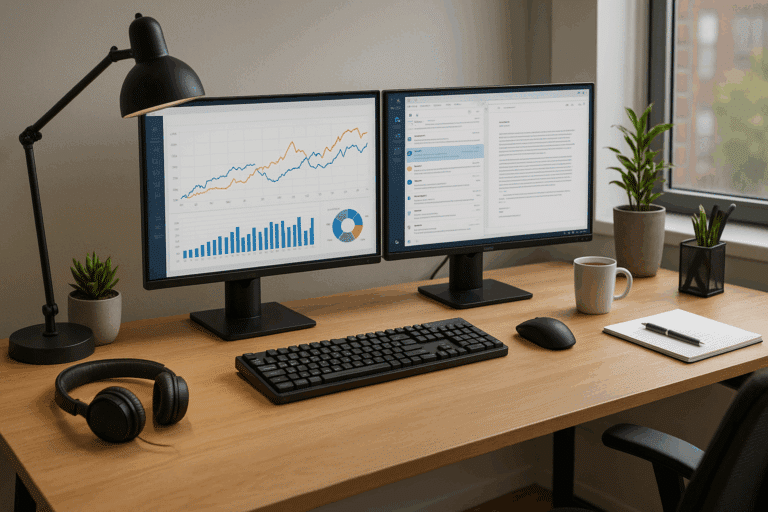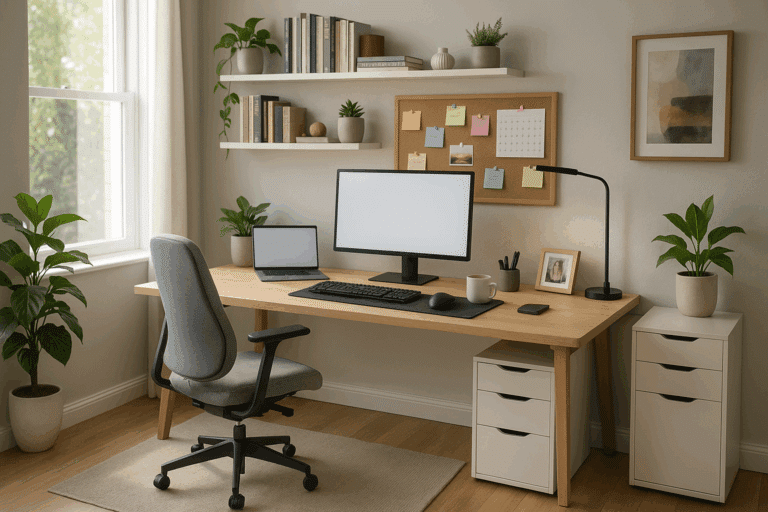In today’s world of technology and productivity, the idea of a minimalist workspace has become more enticing than ever before. 🖥️💡The notion of stripping down your environment to the bare essentials, devoid of unnecessary clutter, may initially sound stark and uninviting. But don’t be mistaken, this strategic approach to workspace design is not about denying yourself the comforts and conveniences of modern work-life. On the contrary, it’s about optimising your surroundings for ultimate productivity and efficiency. 💼💻
This article aims to guide you on how to create a minimalist workspace that fosters focus and efficiency, allowing you to unlock new heights of productivity. Get ready to be inspired, and embrace the less-is-more approach to workspace design. 🚀
A Sneak Peek into the World of Minimalist Workspaces
The modern workspace, whether at home or in an office, is often fraught with distractions. From the endless notifications on your smartphone to the clutter of paperwork on your desk, these distractions can make it difficult to maintain focus and productivity. A minimalist workspace, however, aims to eliminate these distractions, thereby creating an environment that promotes concentration and efficiency.
In the upcoming sections, we will delve into the fundamental principles of minimalist workspace design, the science behind it, and the step-by-step guide to creating your very own minimalist workspace. You will also find tips on maintaining your minimalist workspace and dealing with potential challenges that may arise along the way. 📚💼
The Allure of Minimalism: More Than Just Aesthetics
While minimalist design is certainly aesthetically pleasing, its benefits extend far beyond simple visual appeal. Studies have shown that a clean, uncluttered environment can significantly enhance focus and cognitive functioning. An organised workspace has also been linked to reduced stress and increased productivity. Thus, the allure of minimalism is much more than just a design trend; it’s a practical strategy for improving work performance. 🧠💪
Ready to start your minimalist workspace journey? Keep reading for a comprehensive guide on creating a workspace that maximizes efficiency, fosters a sense of calm, and ultimately, boosts your productivity. 📈
Demystifying Minimalism: Not a One-Size-Fits-All Approach
Minimalism is often misconstrued as a rigid concept, but in reality, it is quite flexible. The essence of minimalism lies not in the absence of things but rather, in the intentional choice of what to include in your space. This means that your minimalist workspace doesn’t have to resemble a stark, empty room; instead, it can be a reflection of your personal style and work needs, minus the unnecessary clutter. 🖥️📖
We will explore how to identify what’s essential for your workspace and how to eliminate distractions for maximum efficiency. You’ll also find practical tips on incorporating personal elements into your minimalist workspace without compromising its functionality. Get ready to discover a new way of working that promotes focus, clarity, and productivity. 🎯
So, whether you’re a seasoned minimalist or just beginning your journey towards a clutter-free workspace, this article is packed with insights, tips, and tricks to help you create and maintain a minimalist workspace that is both efficient and productive. Let’s dive in! 🌊
🔎 Understanding Minimalism in the Workspace
In recent years, the concept of minimalism has gained traction in various areas of life, from fashion to home décor, and now, to workspace design. Minimalism is a philosophy that emphasizes the reduction of elements to only the essentials, creating space for focus, clarity, and productivity. The minimalist workspace, therefore, is about stripping down your working environment to the bare essentials, which in turn can boost efficiency and productivity. But, how does one achieve such a workspace?
In this article, we’ll explore the elements of a minimalist workspace, the benefits of adopting this approach, and practical steps to creating your own. Keep in mind that minimalism doesn’t mean removing all personal items or working in a sterile environment. Instead, it’s about eliminating distractions and creating a workspace that supports your productivity and wellbeing. (Video: “How to Create a Minimalist Workspace,” by Matt D’Avella on YouTube)
Let’s delve into this concept and see how you can create a minimalist workspace for ultimate productivity.
💡 Elements of a Minimalist Workspace
The minimalist workspace is more than just a tidy desk. It includes a variety of elements that come together to create an environment conducive to focus and efficiency. Here are three key components:
1. Clutter-Free Space
A clutter-free space is a hallmark of a minimalist workspace. It’s about keeping only what you need at your fingertips. This means removing unnecessary items from your desk, walls, and overall workspace. A clean, clutter-free space is less distracting, making it easier for you to concentrate.
2. Functional Furniture
Choosing the right furniture for your workspace is essential. You should opt for functional, comfortable, and aesthetically pleasing pieces that serve your needs. Whether it’s a height-adjustable desk or an ergonomic chair, the furniture in your minimalist workspace should promote comfort and efficiency.
3. Smart Storage Solutions
Storage plays a crucial role in maintaining a clutter-free space. It helps keep your essentials organized and within reach, while keeping your workspace clean. Consider using shelves, drawers, and boxes to store your materials neatly.
🚀 The Benefits of a Minimalist Workspace
While the aesthetics of a minimalist workspace might be appealing, its real value lies in the benefits it offers for productivity and wellbeing. Here are three key benefits:
1. Enhanced Focus
By removing unnecessary items and distractions from your workspace, you can concentrate better on your tasks. This can lead to increased productivity and efficiency.
2. Reduced Stress
A cluttered workspace can be a source of stress. On the other hand, a minimalist workspace creates a sense of calm and order, reducing stress and promoting wellbeing.
3. Increased Efficiency
Having only what you need in your workspace means less time wasted looking for things. This makes your workflow more efficient, saving you time and effort.
🔨 How to Create a Minimalist Workspace
Creating a minimalist workspace is a process that involves decluttering, organizing, and making intentional choices. Here’s a step-by-step guide:
1. Declutter
Start by removing everything from your workspace. Then, evaluate each item and decide if it’s necessary. If not, get rid of it. This step might be challenging, but it’s essential to creating a minimalist workspace.
2. Choose the Right Furniture
Once your space is decluttered, consider your furniture. Choose pieces that are functional, comfortable, and match your aesthetic preference. Remember, less is more.
3. Organize
Now that you have only the essentials, it’s time to organize. Use smart storage solutions to keep your items neat and within reach. This step is crucial in maintaining your minimalist workspace.
Creating a minimalist workspace is not about achieving perfection, but about making your space work for you. It’s about creating an environment that promotes productivity and efficiency, while also enhancing your wellbeing. So, why not give it a try? Start decluttering today and experience the benefits of a minimalist workspace. (Video: “Minimalist Desk Setup,” by Sara Dietschy on YouTube)
📊 Minimalist vs Traditional Workspace: A Comparison
To give you a clearer understanding of how a minimalist workspace differs from a traditional one, here’s a comparative table:
| Minimalist Workspace | Traditional Workspace | |
|---|---|---|
| Design | Simple, clean, and clutter-free | Can be cluttered and full of distractions |
| Furniture | Functional, comfortable, and minimal | Can be excessive and distracting |
| Storage | Smart solutions to keep essentials organized | May lack organization, leading to wasted time searching for items |
| Benefits | Enhanced focus, reduced stress, increased efficiency | Can cause distractions, stress, and inefficiency |
As you can see, the minimalist approach offers numerous benefits for your productivity and wellbeing. While it may require some effort to create and maintain, the rewards are well worth it. So, are you ready to transform your workspace and boost your productivity? Start creating your minimalist workspace today!

Conclusion
In conclusion, this article has deeply delved into the intricate world of software engineering and information technology, providing a wealth of information that aims to explain complex concepts in a comprehensible and engaging manner. Throughout the discourse, we have examined diverse aspects of these fields, focusing particularly on their relevance in today’s increasingly digital and interconnected world. 🌐💻
We started by exploring the fundamentals of software engineering and IT, giving you a robust understanding of what these fields entail. From software development methodologies to the role of IT in businesses, we covered a broad range of topics that would equip any reader, whether a novice or an expert, with the necessary knowledge to navigate the complex landscape of these fields. 📘🧠
One of the critical points discussed was the relevance of good software engineering practices in delivering high-quality software products. It was emphasized that these practices are not mere theoretical constructs, but practical guidelines that ensure the creation of software that is reliable, efficient, and secure. This argument was further reinforced with real-world examples and case studies. 👨💻👩💻
Another significant topic discussed was the integral role of IT in today’s businesses. From facilitating communication to improving operational efficiency and driving innovation, IT’s importance cannot be overstated. The article also highlighted how IT can provide a competitive edge in the modern business landscape, citing relevant examples from various industries. 🏢📈
However, just understanding these concepts is not enough. It is crucial to apply this knowledge in real-life situations, whether in your career or personal projects. The purpose of this article was not just to impart knowledge, but to inspire you to leverage this understanding to make informed decisions, solve complex problems, and drive innovation in your respective fields. 💡🚀
So, how will you apply what you have learned? Feel free to share your thoughts, comments, or questions below. Your input can help spark meaningful discussions and enrich our collective understanding of these subjects. Also, do not hesitate to share this article with your friends or colleagues who might find this information useful. 🗣️👥
For further reading and research, consider checking out these resources:
– ACM (Association for Computing Machinery)
– IEEE Computer Society
– Clean Code: A Handbook of Agile Software Craftsmanship by Robert C. Martin
Remember, the journey of learning never ends. Keep exploring, keep learning, and keep innovating. The future of software engineering and IT is in your hands! 🎓🚀
Reference:
– Martin, R. C. (2008). Clean Code: A Handbook of Agile Software Craftsmanship. Prentice Hall.
– ACM Digital Library. (n.d.). https://dl.acm.org/.
– IEEE Xplore Digital Library. (n.d.). https://www.computer.org/csdl/home.



